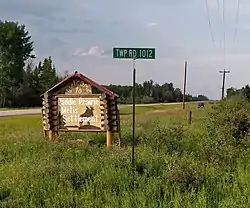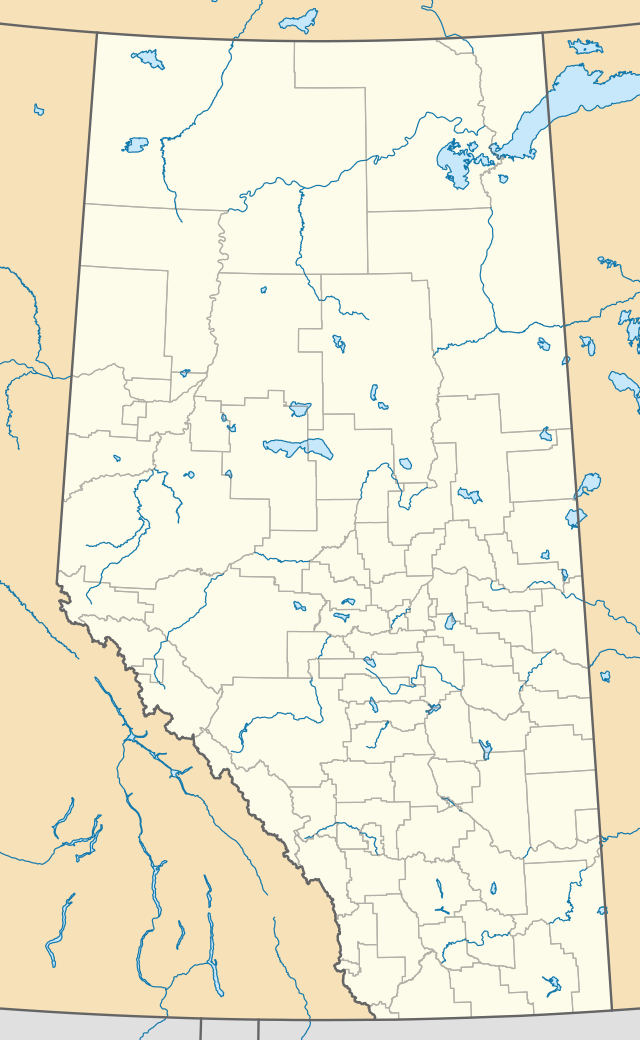Paddle Prairie Metis Settlement
Paddle Prairie Metis Settlement is a Metis settlement in northern Alberta, Canada, along the northern boundary of the County of Northern Lights.[4] It is located along the Mackenzie Highway (Highway 35), approximately 72 km (45 mi) south of the Town of High Level. Paddle Prairie Metis Settlement is the largest of eight Metis Settlements in the Province of Alberta. The community is rich in timber, natural resources and agricultural land. The community is also known for constructing solar power generating units for several of its community buildings.
Paddle Prairie | |
|---|---|
Metis settlement | |
| Paddle Prairie Metis Settlement Keg River Metis Colony No. 1 (formerly) | |
 Southern boundary of Paddle Prairie | |
 Boundaries of Paddle Prairie | |
 Location within County of Northern Lights | |
 Paddle Prairie Location within Alberta | |
| Coordinates: 57°57′N 117°28′W | |
| Country | Canada |
| Province | Alberta |
| Region | Northern Alberta |
| Planning region | Lower Peace |
| Municipal district | Northern Lights |
| Established | May 9, 1939[1] |
| Government | |
| • Chair | Eldon Armstrong |
| • Governing body | Paddle Prairie Metis Council |
| Area (2016)[3] | |
| • Land | 1,738.82 km2 (671.36 sq mi) |
| Population (2016)[3] | |
| • Total | 544 |
| • Density | 0.3/km2 (0.8/sq mi) |
| Time zone | UTC-7 (MST) |
| • Summer (DST) | UTC-6 (MDT) |
| Website | https://paddleprairiemetis.com/ |
History
The Great Depression of the 1930s saw much deprivation among the nomadic Métis population of Alberta, estimated at about 11,000 in 1936. A royal commission was formed to investigate the living conditions of Alberta's "half-breeds" (as the Métis were known), who were then squatting on road allowances with no ready sources of cash income, or trapping in remote areas without access to education or health services. Métis children in urban areas were driven away from public schools by the ridicule and humiliation of white pupils, with an estimated 80% of the provincial Métis population receiving no education whatsoever.
This Ewing Commission saw agriculture, particularly stock-raising, as the means by which the Métis could be made into "self-supporting citizens". Farm colonies, in which the Métis themselves would provide most of the physical labour, would be a suitably inexpensive relief scheme for the cash-strapped Alberta government to implement.[5]
Following these recommendations, the 1938 Metis Population Betterment Act enabled unoccupied Crown land to be set aside for the creation of new Métis settlements. Eleven were originally created by Order-in-Council through 1938 and 1939 – Wolf Lake, Utikuma Lake (now Gift Lake), Cold Lake, Marlboro, Keg River (now Paddle Prairie), Big Prairie (now Peavine), Touchwood, Goodfish Lake (now Kikino), Elizabeth, Fishing Lake, and East Prairie. Caslan (now Buffalo Lake) was the final addition, reserved for Métis veterans returning from World War II before being thrown open to general settlement in 1951.[6]
Settlement at Paddle Prairie progressed rapidly. A 1941 report of the Alberta Bureau of Public Welfare recorded nineteen heads of families resident in the area, with a total population of 72. The settlement's central village was established at its approximate geographic center, the Paddle Prairie proper, an area of open land and productive soil, where a lumbering operation produced 91,372 board feet of rough sawn lumber. From here, 23 kilometres (14 mi) of road was cleared to a landing on the Peace River, suitable for the unloading of supplies.[7]
Geography
The largest and most northerly of Alberta's Metis settlements, Paddle Prairie consists of approximately seventeen townships. It is bounded by the Peace River on its eastern border, where the La Crete ferry still operates.
Legal land description
The exact boundaries of the Paddle Prairie settlement, as described in its enabling legislation, are as follows:
That portion of Township 102, Range 19, west of the Fifth Meridian which lies west of the Peace River;
That part of Township 102, Range 20, west of the Fifth Meridian, which lies west of the Peace River;
That part of Township 103, Range 19, west of the Fifth Meridian, which lies west of the Peace River;
That part of Township 103, Range 20, west of the Fifth Meridian, which lies west of the Peace River;
All of Township 102, Ranges 21, 22, and 23, west of the Fifth Meridian;
All of Township 103, Ranges 21 and 23, west of the Fifth Meridian;
All of Township 103, Range 22, west of the Fifth Meridian, excepting the—
N.E. 1⁄4 of Section 10,
S.W. 1⁄4 of Section 13,
N.W. 1⁄4 of Section 13,
S.E. 1⁄4 of Section 14.— Alberta Order-in-Council 549-39[1]
Demographics
As a designated place in the 2016 Census of Population conducted by Statistics Canada, the Paddle Prairie Metis Settlement recorded a population of 544 living in 185 of its 240 total private dwellings, a decline of 3.2% from its 2011 population of 562. With a land area of 1,738.82 km2 (671 sq mi), it had a population density of 0.3 inhabitants per square kilometre (0.8/sq mi) in 2016.[3]
As a designated place in the 2011 Census, Paddle Prairie had a population of 562 living in 182 of its 225 total dwellings, a growth of 160.2% from its 2006 population of 216. With a land area of 1,716.72 km2 (662.83 sq mi), it had a population density of 0.3 inhabitants per square kilometre (0.8/sq mi) in 2011.[8]
The population of the Paddle Prairie Metis Settlement according to its 2009 municipal census was 1,089.[9]
References
- "Unoccupied Provincial Lands set Aside for a Metis Colony in the Keg River Area". Order-in-Council No. 547-39 of May 9, 1939. Legislative Assembly of Alberta.
- "Municipal Officials Search". Alberta Municipal Affairs. September 22, 2017. Retrieved September 25, 2017.
- "Population and dwelling counts, for Canada, provinces and territories, and designated places, 2016 and 2011 censuses – 100% data (Alberta)". Statistics Canada. February 8, 2017. Retrieved February 9, 2017.
- "Specialized and Rural Municipalities and Their Communities" (PDF). Alberta Municipal Affairs. November 5, 2012. Retrieved November 20, 2012.
- Report of the Ewing Commission. Edmonton. February 15, 1936.
- "About Us". Retrieved August 2, 2019.
- Bureau of Public Welfare (January 31, 1941). Activities in Connection with the Betterment of the Metis Population. Government of Alberta.
- "Population and dwelling counts, for Canada, provinces and territories, and designated places, 2011 and 2006 censuses (Alberta)". Statistics Canada. February 8, 2012. Retrieved April 7, 2012.
- "2010 Official Population List" (PDF). Alberta Municipal Affairs. September 15, 2010. Retrieved May 21, 2011.
